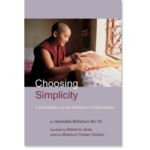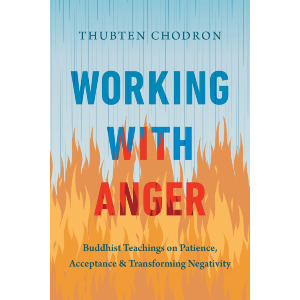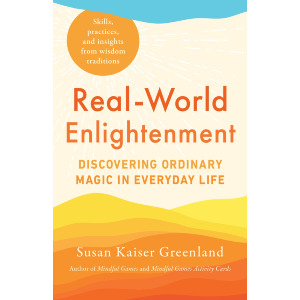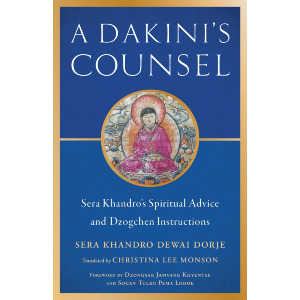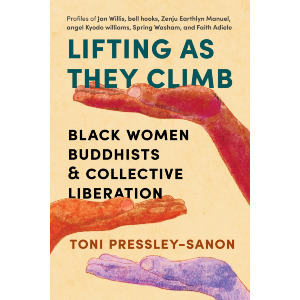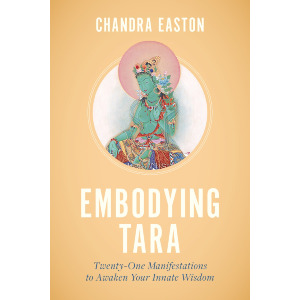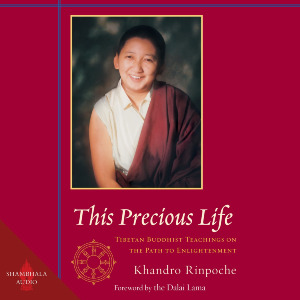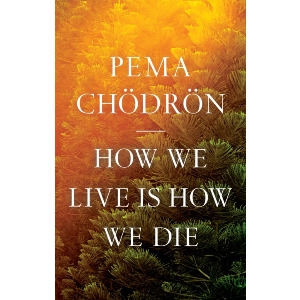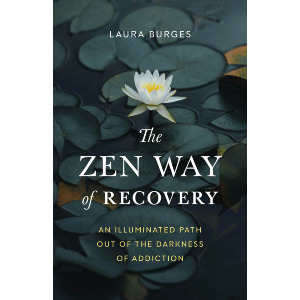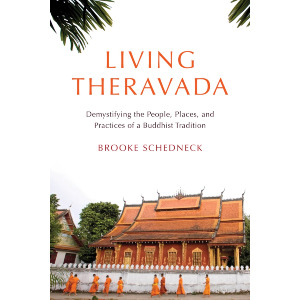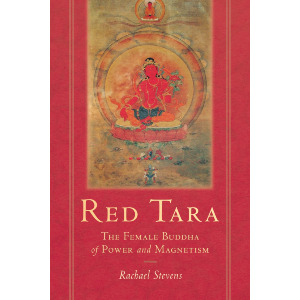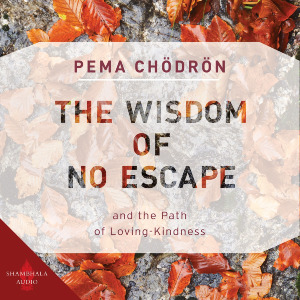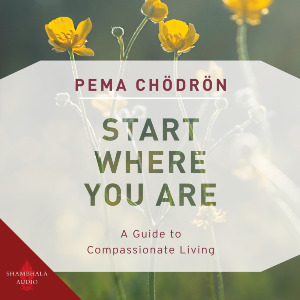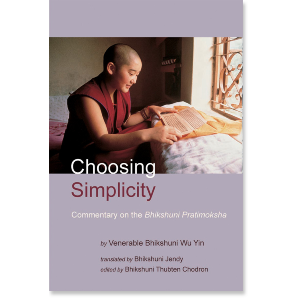| The following article is from the Autumn, 2000 issue of the Snow Lion Newsletter and is for historical reference only. You can see this in context of the original newsletter here. |
Commentary on the Bhikshuni Pratimoksha
by Venerable Bhikshuni Wu Yin trans, by Bhikshuni Jendy Shih ed. by Bhikshuni Thubten Chodron 330 pp. #CHSI $15.95
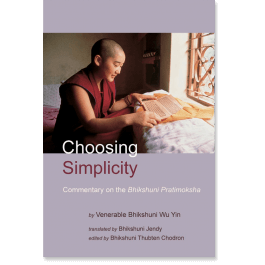
More than a handbook for a Buddhist monastic life, this text offers guidelines to all who wish to conduct their day-to-day lives more mindfully. Those who have not chosen to dwell in a religious community still need to live peacefully with their neighbors. Being clear about boundaries, motivations, and how actions may be interpreted by others can be helpful.
Choosing simplicity in our affluent society means choosing sanity. Christians as well as Buddhists are discovering how monastic values can enrich their lives as lay people. For monastics and lay people alike, Choosing Simplicity will be a book worth reading.BROTHER DAVID STEINDL- A ST, O.S.B. author of A Listening Heart
If monasticism is necessary for the establishment of Buddhism in a new land, then Western countries have some catching up to do. Choosing Simplicity is an important contribution. The book not only helps nurture an understanding of the meaning and value of Buddhist monasticism, but also offers essential commentary in simple language for Buddhists in the West who choose a monastic lifestyle. ARMA LEKSHE TSOMO, Univ. of Hawaii
VENERABLE WU YIN is a Chinese bhikshuni (fully ordained Buddhist nun) from Taiwan. She was born in 1940, received her novice vows in 1957 and her bhikshuni vows in 1959.
The Importance of the Precepts
I make obeisance to all the Bud- dhas, the Dharma, and the Sangha. The Dharma in the Vinaya will now be expounded so the true Dharma will abide forever.
The Dharma and the Vinaya are traced back to our teacher, Shakya- muni Buddha, who lived in the sixth century B.C.E. Having initially spread throughout Asia, his teachings are now found all over the world and have benefited millions of people throughout history.
Shila, or ethical discipline, means freedom from emotional disturbance and is an attitude of non-harmful- ness. Training ourselves in ethical discipline, in conjunction with training in other aspects of the Dharma, extinguishes the three poisonous attitudes of ignorance, attachment, and anger and leads us to liberation. The main body of teachings on ethical discipline are found in the Vinaya Pitaka or basket. Thus the term Vinaya refers to the collection of scriptures teaching ethical discipline as well as to the process of subduing infractions.
Among the various Vinaya scriptures, the most essential ones are the Bhikshu Pratimoksha Sutra and the Bhikshuni Pratimoksha Sutra, which detail the precepts of the fully ordained monks and nuns respectively. Pratimoksha means self-liberation, and refers to the goal of practicing the Vinaya one's own liberation from the bondage of cyclic existence and the attainment of nirvana. Pratimoksha can also refer to means of attaining one's own liberation, that is, the eight types of pratimoksha vows: those of the bhikshu, bhikshuni, shikshamana, shramanera, shramanerika, upasaka, upasika, and the one-day vow. In addition, in a general sense, prati- mokshamaybe used to refer to all the guidelines and precepts explained in the Vinaya.
Precepts are the specific rules established by the Buddha to help his disciples avoid misdeeds and wrongdoings. The scope of the precepts' influence includes our conduct, habits, character, and mental states. Precepts are not commandments, but guidelines to help us subdue our physical and verbal actions, become more aware of our mental motivations, and live harmoniously with those around us. The precepts are not an external ideal being forced upon us, but points for training that we voluntarily undertake.
As Buddhadharma spread from place to place in ancient times, different Vinaya traditions arose. Chinese Buddhists follow the Dharmaguptaka Vinaya, while the Tibetans follow the Mulasarvastivada Vinaya, and Buddhists in Sri Lanka, Thailand, Cambodia, Burma, and so on follow the Theravada Vinaya. The number of precepts in these traditions varies. For bhikshunis, the Dharmaguptaka Vinaya has 348 precepts, Mulasarvastivada has 364, and the Theravada 311. The bhikshus in those traditions respectively have 250, 253, and 227 precepts. The Vinaya of the various schools are remarkably consistent in the meaning of the precepts considering that each tradition was passed on orally in its own geographical area for many centuries before being written down. Nevertheless, a detailed analysis of this is beyond the scope of this book.
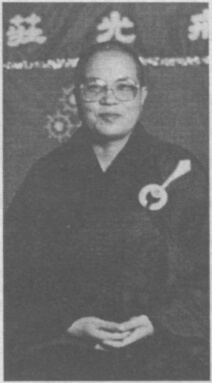
Verierable Bhikshuni Wu Yin
I have put the bhikshuni precepts into categories according to topic, for example, those concerning sexual conduct, listening to admonition, methods for procuring the requisites for daily life, and so on. In this way, the various areas of a nun's life will become clear, as will the Buddha's guidelines for relating to those areas in a healthy and pure way. The basic topics to be explained are: members of the sangha, joining the sangha, the poshadha to purify and restore our precepts, basic requirements for remaining a monastic, precepts dealing with sexual contact, stealing, and other parajika, accepting admonition, right livelihood, resources for monastic life, organization in the Buddhist community, and community life.
Any sincerely interested person whether he or she is a monastic or notmay study the monastic precepts. However, when the bhikshus or bhikshunis do their bimonthly poshadha ceremony, only the bhikshus or bhikshunis may attend. If one has not taken the full precepts, he or she has no need to purify them through the poshadha rite. In addition, the sangha members may want to discuss privately issues relating specifically to their community at that time.
As Buddhism has spread from one country to another, certain elements have changed according to different environments and cultures. In this regard, we must consider some important issues. For example, what a'daptations can and should be made in different communities? How should monastics from various cultures, ethnic groups, and backgrounds be trained? How do the climate, geography, society, culture, and times in which we live affect how we practice Vinaya? I will not go into these questions at this moment, but keep them in mind as you study and practice the Vinaya In exploring these issues, we must be open- minded and not expect to find one right answer.
Because the geography, climate, customs, culture, political situation, and economics have changed since the time of the Buddha, the circumstances in which we currently practice have to be taken into account. Some people advocate following every precept set up by the Buddha literally. Do you think this is possible? On the other hand, if we do not follow the Buddha's precepts, are we the Buddha's disciples? What does it mean to follow the Buddha's precepts? Are there different ways of doing so? These are serious questions to reflect upon, and people will come to different conclusions.
In investigating this, we must distinguish the fundamental from the secondary teachings of the Buddha. I will explain the original teachings in the Vinaya Pitaka and then sometimes discuss how the bhikshuni sangha at the Luminary Temple in Taiwan practices them. In this way, you will see one example of how the Chinese monastic community connects the tradition to the modern situation. With this as a background, Westerners will have some tools for bringing the Vinaya into their own cultures in a pure, yet practical, way.
Bhikshunis are religious practitioners and are part of the sangha. The life style of a bhikshuni is one of spiritual practice. Since most bhikshunis live in a community, spiritual practice and community life are related. Joining the sangha is a voluntary act; we are willing and choose to live our lives as religious practitioners.
Because this is our wish, we want to receive proper and complete training in the life style we have chosen, and having done that, we are committed to implement it in practice. If we decide not to be a serious monastic practitioner, we can return our vow. No one forces us to become or to remain a bhikshuni. We are free to decide. The commitment to monastic practice comes from within us.
When we choose to join the sangha,
we have to make some changes because we are entering a community. The bhikshuni sangha as a whole is our community, whether or not we live in a particular monastery. To be part of the bhikshuni sangha, we need to adapt and follow its way of life. Some actions are prohibited while others are prescribed. Doing prohibited actions, such as engaging in sexual contact, killing, stealing, lying, and so forth, violates the precepts. Similarly, neglecting to do prescribed actions, such as ordination, poshadha, rains retreat, and so on, violates the precepts. These practices are done in a community with a certain number of people and the procedure has to be legal, that is, done in the manner the Buddha described. New nuns should realize that monastic ordination is not just between them and their teacher. Rather, they are entering a community of nuns and will be guided, supported, and trained by the bhikshunis.
InThe Path of Purification (Visuddhimagga), the bhikshuni precepts are put into four categories:
1. Moral behavior for human beings
2. The method to discipline our senses
3. The livelihood of a monastic
4. Daily encounters with people, etiquette, and interactions with people
Understanding the origin of each preceptthe circumstances under which the Buddha established itis necessary to categorize them according to importance or according to topic. The meaning of a precept is not always clear from its wording. For this reason, examining the incident triggering that precept is important.
For example, in the Buddha's time, a group of bhikshus was bathing in a pond. Beginning before sunrise, they continued for many hours, enjoying the water and helping each other put medicine on their bodies. Meanwhile, King Bimbisara waited until nightfall for the bhikshus to finish so that he could bathe. By the time the king had finished his bath, the gates of the city were locked for the evening, and he had to sleep outside. The Buddha heard about the situation and established the following precept, which for bhikshunis reads:
Prayascittika, 41: A healthy bhiks- huni may take a bath once every half month. If she bathes more than that, she is commits a prayascittika, unless it is done at an allowable time. The allowable times are when the weather is hot, when she is sick, when she works, when it is very windy, when it rains (and she gets wet), and when she is traveling. These are the times.
According to this precept, all healthy bhikshus and bhikshunis should not bathe more than once every half a month. However, when certain situations occurred and the Buddha was consulted, he made exceptions to this precept. For example, if monastic is sick, if the weather is hot, if a monastic has done manual labor or walked for a long time, he or she is exeirfpt and may bathe. Nowadays, if we bathe only twice a month, what will the laypeople say? By paying close attention to the circumstances under which this precept was established, we will see the Buddha's real purpose and will be able to adapt it to our present circumstances. ä_æ

